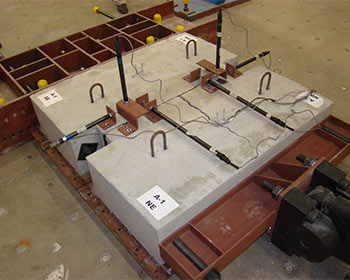

MPC Research Reports |
| Title: | Tolerances for Placement of Tie Bars in Portland Cement Concrete Pavement |
| Authors: | Ahmad A. Ghadban, Nadim I. Wehbe, and Walker Olson |
| University: | South Dakota State University |
| Publication Date: | Aug 2020 |
| Report #: | MPC-20-417 |
| Project #: | MPC-440 |
| TRID #: | 01751953 |
| Keywords: | alignment, concrete pavements, joints (engineering), laboratory tests, literature reviews, pavement performance, Portland cement concrete, tie bars, tolerances (engineering) |
 Longitudinal joints in Portland Cement Concrete (PCC) pavement slabs require tie (dowel) bars to control joint opening resulting from thermal stresses. Inspections of PCC pavements by the South Dakota Department of Transportation using ground penetrating radar revealed that it is common for tie bars to be either misplaced or completely missing at some locations. It is unclear if tie bar misplacement results in increased maintenance costs or reduced pavement service life. Tie bar misalignment tolerances that have been established in existing specifications are not based on PCC pavement research or economic data. This research study investigates the effects of different tie bar misalignments on the tie bar performance to establish acceptable placement tolerances. A comprehensive literature review was carried out to assess existing specifications and past studies. The effect of different misalignment configurations and magnitudes on the longitudinal joint performance was examined by conducting laboratory experiments on PCC slabs incorporating four different misalignment configurations and four different misalignment magnitudes. The results showed that vertical and longitudinal translation misalignments had no significant effect on the performance of the longitudinal joint, while vertical skew misalignment had a mild effect only on joint faulting. Horizontal skew misalignment, however, caused a significant increase in both joint opening and joint faulting. Horizontal skew misalignment also caused a significant decrease in the tie bar load that initiates bar yielding. A simplified method was developed to conservatively estimate the allowable load in a tie bar for horizontal skew misalignments. Based on the results, recommendations are to reduce the horizontal skew tolerance limit from 18 in. to no more than 16 in.
Longitudinal joints in Portland Cement Concrete (PCC) pavement slabs require tie (dowel) bars to control joint opening resulting from thermal stresses. Inspections of PCC pavements by the South Dakota Department of Transportation using ground penetrating radar revealed that it is common for tie bars to be either misplaced or completely missing at some locations. It is unclear if tie bar misplacement results in increased maintenance costs or reduced pavement service life. Tie bar misalignment tolerances that have been established in existing specifications are not based on PCC pavement research or economic data. This research study investigates the effects of different tie bar misalignments on the tie bar performance to establish acceptable placement tolerances. A comprehensive literature review was carried out to assess existing specifications and past studies. The effect of different misalignment configurations and magnitudes on the longitudinal joint performance was examined by conducting laboratory experiments on PCC slabs incorporating four different misalignment configurations and four different misalignment magnitudes. The results showed that vertical and longitudinal translation misalignments had no significant effect on the performance of the longitudinal joint, while vertical skew misalignment had a mild effect only on joint faulting. Horizontal skew misalignment, however, caused a significant increase in both joint opening and joint faulting. Horizontal skew misalignment also caused a significant decrease in the tie bar load that initiates bar yielding. A simplified method was developed to conservatively estimate the allowable load in a tie bar for horizontal skew misalignments. Based on the results, recommendations are to reduce the horizontal skew tolerance limit from 18 in. to no more than 16 in.
Ghadban, Ahmad A., Nadim I. Wehbe, and Walker Olson. Tolerances for Placement of Tie Bars in Portland Cement Concrete Pavement, MPC-20-417. North Dakota State University - Upper Great Plains Transportation Institute, Fargo: Mountain-Plains Consortium, 2020.